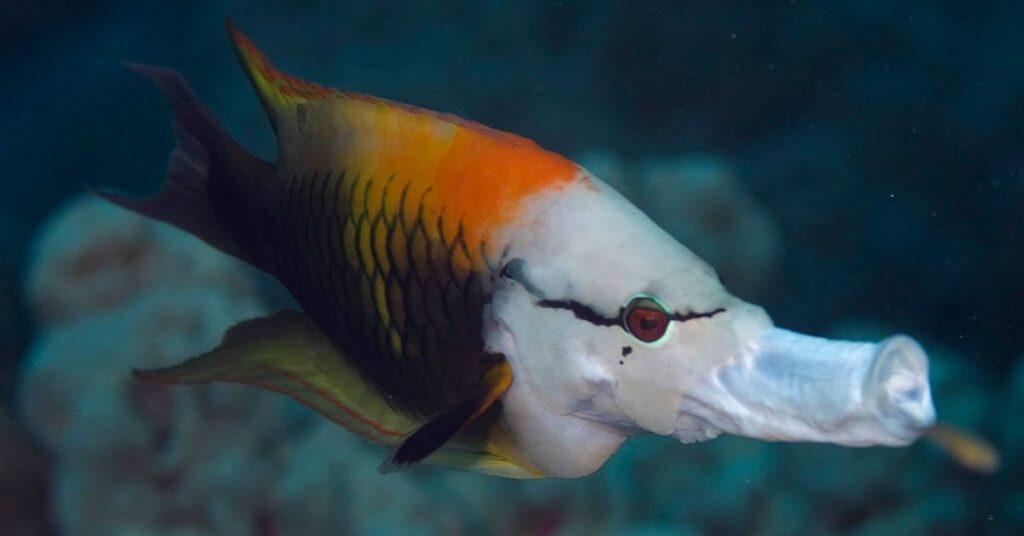At first glance, the slingjaw wrasse (Epibulus insidiator) may seem just like any other ordinary fish. Growing up to around 14 inches long, its juvenile form features a brown body and white stripes, eventually transitioning to a mix of dark brown, yellow, orange, and white in adulthood. Watching it swim around reveals nothing remarkable about it… that is, until it’s time for dinner. Seeing it in action will make you understand how it got its name (and probably wonder if you’re actually watching a horror movie). It extends its jaw from its body, using its protruded mouth like a straw to suck in crabs, shrimps, small fishes, and other unsuspecting prey.
The slingjaw wrasse’s mouth stretches to about 65% the length of its head. It owes this unique ability to the arrangement of ligaments (two of which are enlarged) and bones in its jaw: a specialized four-bar linkage system that enables the slingjaw wrasse to “sling” its upper and lower jaws from its body. It’s a useful skill for nabbing food between coral branches or narrow crevices.
Found in the Indian Ocean and Pacific Ocean (including various areas of the Philippines), the slingjaw wrasse prefers to hunt in reefs, lagoons, and other coral-rich areas, up to 130 feet deep. Interestingly, the slingjaw wrasse has been observed to work with other fish in obtaining hard-to-reach prey. Then again, maybe its underwater cohorts are just too weirded out by its freaky jaw to complain.
Still remember your 5th-grade science classes? Test your knowledge and see if you still remember these facts and fundamental concepts in human anatomy, biology, botany, and other branches of science. Click here to try the “Are You Smarter Than A Pinoy Fifth-Grader” Challenge.
Follow the hashtag #FlipFacts on Facebook and Instagram to get your daily dose of science trivia!
Cover photo: Jason Isley/scubazooimages.com
References
- https://jeb.biologists.org/content/jexbio/159/1/165.full.pdf
- https://books.google.com.ph/books?id=44taDwAAQBAJ&pg=PT50#v=onepage&q&f=false
- https://reefs.com/magazine/aquarium-fish-the-slingjaw-wrasse-epibulus-insidiator-the-fastest-jaw-in-the-west-pacific/
- https://www.aqua.org/Experience/Animal-Index/slingjaw-wrasse
- https://www.fishbase.se/comnames/CommonNamesList.php?id=5606&genusname=Epibulus&speciesname=insidiator&lang=english
- https://www.researchgate.net/publication/227661666_Feeding_mechanism_ofEpibulus_insidiator_Labridae_Teleostei_Evolution_of_a_novel_functional_system
Author: Mikael Angelo Francisco
Bitten by the science writing bug, Mikael has years of writing and editorial experience under his belt. As the editor-in-chief of FlipScience, Mikael has sworn to help make science more fun and interesting for geeky readers and casual audiences alike.










